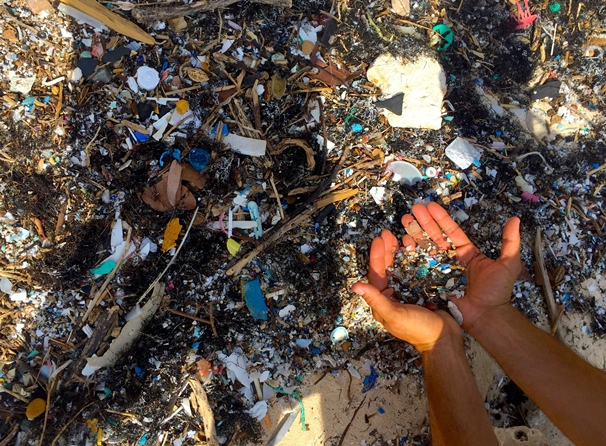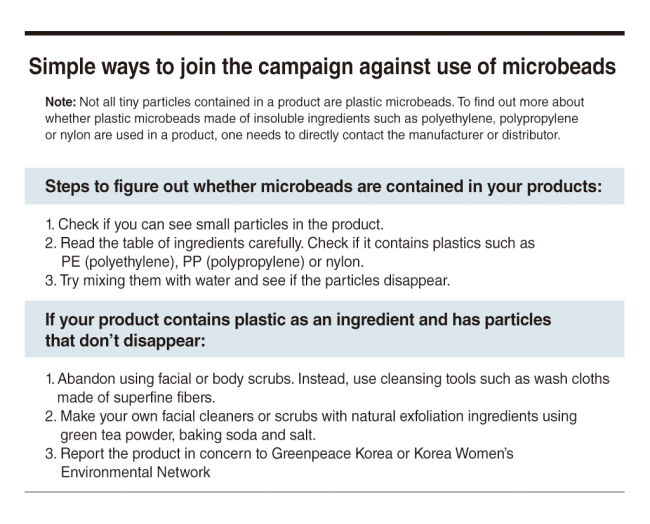When 29-year-old Kim Seo-young heard that tiny plastic pollutants floating in the sea are consumed by fish and may end up on her dinner plate, she did not know it was due to what she uses every day for a face wash.
“At first, I thought microbeads meant something like a sparkly type of jewel,” said Kim, adding that she would not be the only one unaware of it.
A survey by Greenpeace Korea in June found that 78 percent of 1,000 male and female consumers here were not aware of what microbeads are.

These beads are from 10 micrometers to 5 millimeters in diameter, compared to a human hair that is normally a size of 100 micrometers in diameter.
Too small to be filtered, they pass through water purification systems and flow into oceans where marine life can eat them, mistaking them for food.
The composition of microbeads often includes polyethylene (PP), polyethylene terephthalate (PET), polymethlyl methacrylate (PMMA) or nylon, which are not degradable and take at least several decades to dissolve.
Approximately 360,000 microbeads particles are contained in an average 170ml facial cleaner sold in the market, while at least 20 million tons of these plastic pieces end up in the ocean each year, according to United Nations Environment Program data in 2014.
The dangers are not just exclusive to human life who can find these in their food sources.
A 2015 study listed on the Proceedings of the National Academy of Sciences of the United States of America found that nine out of 10 seabirds around the world are likely to have tiny plastic pieces in their stomachs.
Data from the Korea Women’s Environmental Network also showed that every 2.5 in 10 fish -- such as planktons -- here were found to contain plastic wastes inside their stomachs.
“These plastic pieces find their way through sewers and into the sea where they are easily eaten by all sorts of marine animals,” said Park Tae-hyun, a campaigner at Greenpeace Korea.

“Even when cosmetics manufacturers say they use microbeads that are soluble, it is difficult to say that they are 100 percent dissolved -- it is easier to say that they are just broken down into smaller pieces,” he added, underlining the lack of governmental control over the manufacturing of products containing small plastic particles.
Amid rising awareness on marine life and human health risks, petitions and legislative moves on plastic microbeads ban have been growing active around the globe.
In 2015, the U.S. government banned the inclusion of microbeads in consumer products. Taiwan and the United Kingdom are preparing to enact the related laws. Canada officially listed microbeads to the category of toxic chemicals, backed by the United Nations.
In South Korea, as of Monday last week, the petition to ban microbeads in the country has already gathered over 13,000 signatures since the campaign was launched two weeks ago. It aims to gain 20,000 signatures. Renowned cosmetics companies such as L’Oreal, The Bodyshop and Avon have also pledged to stay microbeads-free.
A similar move is starting to appear among local companies as well.
“Amid rising consumer and civic group concerns, we have been using natural alternatives such as nut shells, oats and salt which can be used for the same purpose instead of tiny plastic particles,” a brand manager from a local cosmetic manufacturer which tops the market share here told The Korea Herald, declining to be named.
Last year, the KWEN released a list of some 360 cosmetic goods sold here in the market and whether they contain plastic microbeads.
After the list was released, six manufacturers responsible for 12 listed goods changed their ingredients to environmentally-friendly particles. Additional 55 manufacturers signed voluntary covenants to product microbeads-free products.
The KWEN said it will continue to expand the campaign beyond microbeads containing cosmetics and move on to different category of products.
However, current legislation in South Korea is not able to support the active participation of the related companies.
Without deciding which government ministry will be responsible for regulating microbeads wastes, the Ministry of Oceans and Fisheries kicked off a study to find out how small plastic particles will specifically affect marine life.
Authorities said the result of the study will not come out in the near future as South Korea lacks data regarding the issue.

If the issue is to address the use of microbeads in cosmetics and food, the Ministry of Food and Drug safety would be responsible. If the issue is controlled to include plastic waste on land, the Ministry of Environment would be responsible. If the issue is restricted to plastic wastes that influence ocean pollution, the Ministry of Oceans and Fisheries would be responsible.
Civic groups argue that the government should have a better sense of responsibility regarding plastic debris wastes.
Greenpeace Korea argue that while each company has different standards and regulations handling these beads, with limited voluntary control, the government should step up and draw up a legal solution to deal with manufacturers comprising microbeads in their products.
By Kim Da-sol (ddd@heraldcorp.com)



![[KH Explains] Hyundai Motor’s plan for new landmark keeps hitting bumps](http://res.heraldm.com/phpwas/restmb_idxmake.php?idx=644&simg=/content/image/2024/05/13/20240513050626_0.jpg&u=20240513192803)
![[Grace Kao] American racism against Stray Kids](http://res.heraldm.com/phpwas/restmb_idxmake.php?idx=644&simg=/content/image/2024/05/13/20240513050827_0.jpg&u=)













